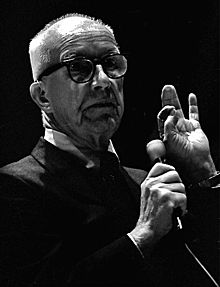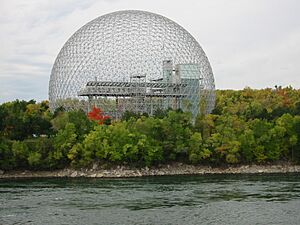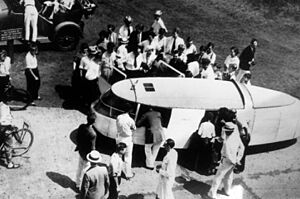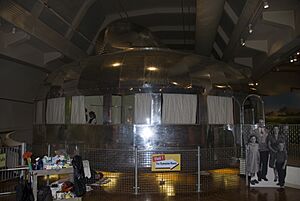Buckminster Fuller facts for kids
Quick facts for kids
Buckminster Fuller
|
|
|---|---|

Fuller in 1972
|
|
| Born |
Richard Buckminster Fuller
July 12, 1895 Milton, Massachusetts, U.S.
|
| Died | July 1, 1983 (aged 87) Los Angeles, California, U.S.
|
| Occupation |
|
| Spouse(s) |
Anne Hewlett
(m. 1917) |
| Children | Allegra Fuller Snyder |
| Awards | Presidential Medal of Freedom (1983) |
| Buildings | Geodesic dome (1940s) |
| Projects | Dymaxion house (1928) |
|
Philosophy career |
|
| Education | Harvard University (expelled) |
|
Notable work
|
|
| Era | 20th-century philosophy |
| Region | Western philosophy |
|
Notable ideas
|
|
|
Influenced
|
|
Richard Buckminster Fuller (July 12, 1895 – July 1, 1983) was an American architect, designer, and inventor. He was also a writer, philosopher, and futurist, someone who thinks about the future. He often signed his name as R. Buckminster Fuller.
Fuller wrote over 30 books. He also created or made popular many terms. These include "Spaceship Earth", "Dymaxion" (like the Dymaxion house and Dymaxion car), "ephemeralization", "synergetics", and "tensegrity".
He invented many things, especially architectural designs. He is most famous for popularizing the geodesic dome. Later, scientists named carbon molecules called fullerenes after him. This was because their shape was similar to his geodesic spheres. Fuller also led Mensa International, a group for people with high IQs, from 1974 to 1983.
Fuller received 28 patents in the United States and many honorary degrees. He won the Presidential Medal of Freedom in 1983, which is a very high award in the U.S.
Contents
Who Was Buckminster Fuller?
Richard Buckminster Fuller was born on July 12, 1895, in Milton, Massachusetts. His parents were Richard Buckminster Fuller and Caroline Wolcott Andrews. His great-aunt was Margaret Fuller, a famous American journalist and women's rights supporter. The name "Buckminster" was a family name. As a child, he tried different versions of his name before settling on R. Buckminster Fuller.
Fuller spent much of his childhood on Bear Island in Maine. He liked to make things from materials he found in the woods. He even made his own tools. By age 12, he had invented a way to move a rowboat using an upside-down umbrella. This allowed the user to face forward while rowing. Later in life, he preferred not to use the word "invention" for his creations.
He learned how to use many tools for working with metal. This experience helped him understand the materials needed for his future projects.
His Education and Early Life
Fuller went to Milton Academy and then Harvard College. He was asked to leave Harvard twice. First, he spent all his money on a party. After being allowed back, he was expelled again for not being serious enough. He felt he didn't fit in with the college social scene.
Between his times at Harvard, Fuller worked as a mechanic in Canada. He also worked in the meat-packing industry. During World War I, he served in the U.S. Navy as a radio operator and a boat commander. After the war, he returned to the meat-packing industry and gained management experience.
In 1917, he married Anne Hewlett. In the early 1920s, he and his father-in-law created the Stockade Building System. This system aimed to build lightweight, fireproof homes. However, the company did not succeed.
A Turning Point in His Life
Fuller faced a very difficult time in 1927. His daughter, Alexandra, had passed away in 1922. Fuller believed their living conditions might have contributed to her illness. This made him want to create better, affordable homes.
When the Stockade company failed in 1927, Fuller lost his job. His family had no savings, and his second daughter, Allegra, was born that year. He thought deeply about his family's struggles while walking around Chicago.
Fuller later said he had a powerful experience that changed his life's direction. He felt like he was floating in a sphere of white light. This experience made him rethink everything. He decided to dedicate his life to "an experiment, to find what a single individual could contribute to changing the world and benefiting all humanity". He wanted to find ways of "doing more with less" so everyone could have more.
New Beginnings
By 1928, Fuller was living in Greenwich Village in New York. He spent a lot of time at a café called Romany Marie's. He decorated the café in exchange for meals and gave informal talks there. Models of his Dymaxion house were even shown at the café.
It was there that he met artist Isamu Noguchi in 1929. They became lifelong friends and worked together on projects, including ideas for the Dymaxion car.
Fuller's Famous Designs
Geodesic Domes
Fuller taught at Black Mountain College in North Carolina in 1948 and 1949. There, he started working on a project that would make him famous: the geodesic dome. While a German engineer, Dr. Walther Bauersfeld, had created a similar dome earlier, Fuller developed his own versions and received U.S. patents for them. He is widely known for popularizing this type of structure.
One of his first domes was built in 1945 at Bennington College. In 1949, Fuller built a geodesic dome that could support its own weight. It was 4.3 meters (14 feet) wide and made of aluminum and vinyl plastic. To show how strong it was, he hung several students from its frame! The U.S. government saw how important this work was. They hired his company, Geodesics, Inc., to make small domes for the Marines. Soon, thousands of these domes were built worldwide.
In 1959, Fuller built his first "continuous tension – discontinuous compression" geodesic dome at the University of Oregon. These special structures used strong tension parts to hold up compression parts that didn't touch each other.
The Dymaxion Chronofile
For 50 years, Fuller developed many ideas and inventions. These often focused on practical and affordable housing and transportation. He kept detailed records of his life, ideas, and philosophy in a daily diary called the Dymaxion Chronofile. He also published 28 books.
Global Recognition

Fuller gained international fame for his large geodesic domes in the 1950s. In 1964, he and architect Shoji Sadao started their own firm, Fuller & Sadao Inc. Their first big project was designing the huge geodesic dome for the U.S. Pavilion at Expo 67 in Montreal. This building is now known as the "Montreal Biosphère".
Fuller became a research professor at Southern Illinois University Carbondale in 1959. He was a "celebrity" professor, giving talks and spending time on campus. His time there was very productive. He also worked with John McHale to start the World Design Science Decade (1965-1975). This project aimed to use science to solve humanity's problems.
He believed that human societies would soon use mostly renewable energy, like solar and wind power. He hoped for a future where everyone could have a good education and enough to live on. Fuller called himself "the property of universe" and his work "the property of all humanity." In 1969, he was named Humanist of the Year.
Fuller's Philosophy
Buckminster Fuller was a Unitarian, a type of Christian. He was also an early environmental activist. He understood that Earth has limited resources. He promoted a idea called "ephemeralization", which means "doing more with less". This means using resources and waste from old products to make new, more valuable ones. This makes the whole process more efficient.
Fuller also created the word "synergetics". This term describes the study of how systems change. He focused on how a whole system behaves, which cannot be predicted by looking at its parts alone.
He was a pioneer in thinking globally about energy and material efficiency in design and engineering. In his book Critical Path (1981), he said that oil, if we had to replace it with current energy, would cost nature "over a million dollars" per gallon to produce. He believed that using such a valuable resource for simple things like commuting to work was a huge waste. He famously said: "There is no energy crisis, only a crisis of ignorance."
Fuller was concerned about sustainability and human survival. But he was always hopeful about humanity's future. He defined wealth as "the technological ability to protect, nurture, support, and accommodate all growth needs of life". He believed that humanity had reached a point where competition for basic needs was no longer necessary. He thought cooperation was the best way for humans to survive. He declared: "selfishness is unnecessary and hence-forth unrationalizable... War is obsolete." He believed a better world needed to include everyone.
Fuller was influenced by Alfred Korzybski's ideas about general semantics, which is about how language affects our thinking.
In his 1970 book I Seem To Be a Verb, he wrote: "I live on Earth at present, and I don't know what I am. I know that I am not a category. I am not a thing—a noun. I seem to be a verb, an evolutionary process—an integral function of the universe."
Fuller became a guide for many in the design and architecture fields. He even gave an award to Drop City, a community of experimental artists, for their "poetically economic" domed homes.
Key Design Projects
The Geodesic Dome
Fuller is most famous for his lattice shell structures called geodesic domes. These domes have been used for military radar stations, public buildings, and exhibition attractions. Fuller's patent for the geodesic dome (U.S. 2,682,235; 1954) was similar to a design by Walther Bauersfeld from 28 years earlier.
These domes are lightweight and stable. Their construction uses simple "tensegrity" principles. The geodesic dome came from Fuller's study of nature's building methods to find design solutions.
Transportation Ideas

The Dymaxion car was a unique vehicle designed by Fuller. It was shown at Chicago's 1933-1934 Century of Progress World's Fair. During the Great Depression, Fuller built three prototypes with naval architect Starling Burgess.
The word Dymaxion combines "dynamic," "maximum," and "tension." It meant getting "maximum gain of advantage from minimal energy input."
Fuller saw the Dymaxion as part of a future "Omni-Medium Transport" that could fly, land, and drive. He focused on its landing and driving abilities. The car had an aerodynamic body for better fuel efficiency. It was lightweight, had a rear-mounted engine, front-wheel drive, and three wheels. The single rear wheel could turn 90 degrees, allowing the Dymaxion to make very tight turns. This often surprised other drivers.
One prototype crashed, sadly killing the driver and injuring passengers. Fuller believed another car caused the accident. However, witnesses said the Dymaxion began to roll over before the other car hit it.
Fuller eventually sold all three prototypes. He said the Dymaxion was never meant to be a commercial product. One of the original prototypes still exists today.
Housing Concepts

Fuller's Dymaxion house was designed to be energy-efficient and inexpensive. While it attracted a lot of interest, only two prototypes were ever built. The term "Dymaxion" here means a "radically strong and light tensegrity structure." One Dymaxion House is on display at the Henry Ford Museum in Dearborn, Michigan.
This house, developed in the 1940s, was round, not a dome. It had cool features like revolving dresser drawers and a special shower that used less water. It was designed to be delivered in two packages. A circular part on top could rotate to use natural winds for cooling.
The Dymaxion House was meant to be lightweight, easy to put together, and cheap to make. It was ideal for people who wanted to move easily. It looked very modern, made of metal and shiny aluminum. The basic model had 90 m2 (970 sq ft) of floor space. Many people ordered them after World War II, but the company formed to build them failed due to management issues.
In 1967, Fuller imagined an offshore floating city called Triton City. He published a report about it the next year. Models of the city even interested President Lyndon B. Johnson.
In 1969, Fuller started the Otisco Project. This project showed how to build large, strong concrete structures on-site without molds or cranes. They used wire mesh and sprayed concrete to create domes up to three stories tall. These buildings were very strong. This ability to build large concrete structures in open space is considered one of Fuller's greatest contributions.
Dymaxion Map and World Game
Fuller, with Shoji Sadao, also designed a unique map called the Dymaxion map. This map shows Earth's continents with very little distortion when printed flat.
In the 1960s, Fuller created the World Game. This was a simulation game played on a huge Dymaxion map. Players tried to solve world problems. Fuller's goal for the game was to "make the world work, for 100% of humanity, in the shortest possible time, through spontaneous cooperation, without ecological offense or the disadvantage of anyone."
Fuller's Personal Style
Buckminster Fuller wore thick glasses because he was extremely farsighted. His hearing was also damaged during his Navy service. He later used electronic hearing aids.
In public, Fuller always wore dark suits. He looked like "an alert little clergyman." He learned that dressing in a way that didn't draw attention to himself helped people focus on his ideas. He joked that his black suit made him look like a "second-rate bank clerk."
His Lifestyle
As he became famous, Fuller traveled a lot, often crossing time zones to give lectures. In the 1960s and 1970s, he wore three watches at once: one for his office time, one for his next destination, and one for his current location. He spent most nights in hotels, traveling for his talks and consulting work.
In the 1920s, Fuller tried sleeping in short naps throughout the day, which he called Dymaxion sleep. He was inspired by how animals like dogs sleep. This allowed him "twenty-two thinking hours a day," which helped him be very productive. He kept this routine for two years but stopped because it didn't fit with his business partners' sleep schedules.
Fuller was known for his amazing stamina throughout his life. Even in his seventies, he was described as "tireless."
He kept detailed records of his life from 1915 to 1983. This collection, called the Dymaxion Chronofile, is about 270 feet (82 m) long! He also kept copies of all his letters. This huge collection is now at Stanford University.
His Unique Language
Buckminster Fuller spoke and wrote in a very unique way. He believed it was important to describe the world as accurately as possible. He often used long sentences and unusual compound words like "omniwell-informed." He also invented his own terms. His speaking style was fast and breathless, with many side thoughts. He called this "thinking out loud."
Fuller always capitalized the word Universe and used it without "the" or "an." He said: "by Universe I mean: the aggregate of all humanity's consciously apprehended and communicated (to self or others) Experiences."
He argued that words like "down" and "up" are confusing because they suggest a flat Earth. He thought "in" and "out" were better because they describe an object's relation to Earth's center. He would tell audiences to say, "I'm going 'outstairs' and 'instairs.'" He believed this helped people feel the "real 'reality'" of living on "Spaceship Earth."
Fuller also created "world-around" to replace "worldwide." He felt "wide" was outdated for a spherical Earth. He believed using old scientific ideas could mislead our understanding. His family also invented "sunsight" and "sunclipse" instead of "sunrise" and "sunset" to move away from the idea that the sun revolves around Earth.
He invented the word "livingry," which is the opposite of weaponry (or "killingry"). Livingry means anything that supports human, plant, and Earth life.
Fuller also invented the term "tensegrity" by combining "tensional" and "integrity." Tensegrity describes structures where shape comes from continuous tension, not just from parts pushing against each other.
"Dymaxion" was created by two advertising people in 1929. They used three words Fuller often used to describe his designs: dynamic, maximum, and tension.
Fuller also helped make the idea of Spaceship Earth popular. He famously said: "The most important fact about Spaceship Earth: an instruction manual didn't come with it."
In his "cosmic fairy tale" Tetrascroll: Goldilocks and the Three Bears, Fuller explained that his unique speaking style came from years of telling this classic story to his daughter. This helped him explore his new theories and how to share them.
Concepts and Buildings
His important concepts and buildings include:
- Dymaxion house (1928)
- R. Buckminster Fuller and Anne Hewlett Dome Home
- Aerodynamic Dymaxion car (1933)
- Prefabricated compact bathroom cell (1937)
- Dymaxion deployment unit (1940)
- Dymaxion map of the world (1946)
- Tensegrity structures (1949)
- Geodesic dome for Ford Motor Company (1953)
- Patent on geodesic domes (1954)
- The World Game (1961) and the World Game Institute (1972)
- Patent on octet truss (1961)
- Montreal Biosphere (1967), United States pavilion at Expo 67
- Fly's Eye Dome
- Dewan Tunku Geodesic Dome, KOMTAR, Penang, Malaysia (proposed 1974, completed 1985)
- Comprehensive anticipatory design science
Influence and Legacy

Many people were influenced by Buckminster Fuller, including: Constance Abernathy, Ruth Asawa, J. Baldwin, Michael Ben-Eli, Pierre Cabrol, John Cage, Joseph Clinton, Peter Floyd, Norman Foster, Medard Gabel, Michael Hays, Ted Nelson, David Johnston, Peter Jon Pearce, Shoji Sadao, Edwin Schlossberg, Kenneth Snelson, Robert Anton Wilson, Stewart Brand, and Jason McLennan.
A special form of carbon called fullerene was named after him. One specific molecule, C60 (buckminsterfullerene or buckyball), looks very much like a spherical version of Fuller's geodesic dome. In 1996, the Nobel Prize in chemistry was given to Harry Kroto, Robert Curl, and Richard Smalley for discovering the fullerene.
On July 12, 2004, the U.S. Post Office released a stamp honoring R. Buckminster Fuller. This was for the 50th anniversary of his geodesic dome patent and his 109th birthday. The stamp looked like the January 10, 1964, cover of Time magazine.
Fuller was featured in two documentary films: The World of Buckminster Fuller (1971) and Buckminster Fuller: Thinking Out Loud (1996).
In June 2008, the Whitney Museum of American Art held a large exhibition called "Buckminster Fuller: Starting with the Universe." It showed models, sketches, and other items from his six decades of work on housing, transportation, and communication.
In 2009, a company started selling spherical magnets as toys called "Buckyballs" because they could form shapes like Fuller's buckyballs. However, these toys later faced safety issues and were recalled.
In 2012, the San Francisco Museum of Modern Art had a show called "The Utopian Impulse." It explored Fuller's influence and his ideas for creating "free energy" and removing carbon from the air.
Patents
Here are some of the inventions Buckminster Fuller received patents for:
- 1927 U.S. Patent 1,633,702 Stockade: building structure
- 1927 U.S. Patent 1,634,900 Stockade: pneumatic forming process
- 1937 U.S. Patent 2,101,057 Dymaxion car
- 1940 U.S. Patent 2,220,482 Dymaxion bathroom
- 1944 U.S. Patent 2,343,764 Dymaxion deployment unit (sheet)
- 1944 U.S. Patent 2,351,419 Dymaxion deployment unit (frame)
- 1946 U.S. Patent 2,393,676 Dymaxion map
- 1954 U.S. Patent 2,682,235 Geodesic dome
- 1959 U.S. Patent 2,881,717 Paperboard dome
- 1959 U.S. Patent 2,905,113 Plydome
- 1959 U.S. Patent 2,914,074 Catenary (geodesic tent)
- 1961 U.S. Patent 2,986,241 Octet truss
- 1962 U.S. Patent 3,063,521 Tensegrity
- 1963 U.S. Patent 3,080,583 Submarisle (undersea island)
- 1964 U.S. Patent 3,139,957 Aspension (suspension building)
- 1965 U.S. Patent 3,197,927 Monohex (geodesic structures)
- 1965 U.S. Patent 3,203,144 Laminar dome
- 1967 U.S. Patent 3,354,591 Star tensegrity (octahedral truss)
- 1970 U.S. Patent 3,524,422 Rowing needles (watercraft)
- 1974 U.S. Patent 3,810,336 Geodesic hexa-pent
- 1975 U.S. Patent 3,863,455 Floatable breakwater
- 1975 U.S. Patent 3,866,366 Non-symmetrical tensegrity
- 1979 U.S. Patent 4,136,994 Floating breakwater
- 1980 U.S. Patent 4,207,715 Tensegrity truss
- 1983 U.S. Patent 4,377,114 Hanging storage shelf unit
See also
 In Spanish: Richard Buckminster Fuller para niños
In Spanish: Richard Buckminster Fuller para niños
- Amundsen-Scott South Pole Station
- The Buckminster Fuller Challenge
- Bucky Ball
- Cloud Nine (tensegrity sphere)
- Design science revolution
- Drop City
- Emissions Reduction Currency System
- Kārlis Johansons, tensegrity innovator
- Kenneth Snelson, tensegrity sculptor
- Noosphere
- Old Man River's City project
- Space frame
- Spome
- Whole Earth Catalog
- Post-scarcity economy





